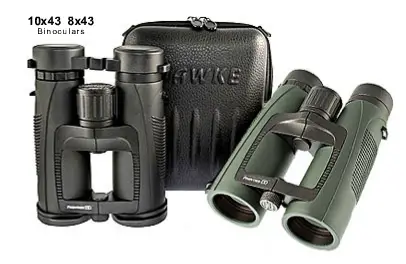


Hawke Frontier ED 8 x 43 Premium Binoculars

The test article is Hawke Sports Optics extra-low dispersion glass equipped “Frontier ED” magnesium body set of binoculars in the green body edition, shown above on the right. They are Hawke #HA3782, are eight power, with forty-three millimeter objective lenses. The main feature is the “ED” glass, the notion of which promises better color fidelity than possible with conventional glass. ED glass, as best I can determine, came about in the mid 1970s. Chromatic aberration is at least a five dollar word, unadjusted for inflation. Whether chromatic aberration, distortion, or achromaticism, it all refers to color fringing more or less.
Though you'd have to be a true optical aficionado to discuss all the fine points, something I'm distintly not, the goal is to reduce or eliminate purple, green, cyan, or other unwanted colors around contrasting areas of the image. When light goes through a prism it slows down and gets bent. ED glass bends the light less, so you have less color fringe issues. That's the short version, anyway. Here are the basic specifications.
Model:
HA3782 8x43 GREEN
Prism: Roof BAK4
Coating: Phase ED
FOV at 1000 yards: 466 feet
Eye Relief: 0.65 inches
Near Focus: 6.6 feet
Length: 6.57 inches
Weight: 26.2 ounces
Street Price: Approx. $350
If there is any general negative associated with ED glass for the hunter, it would be weight. To compensate for that, Hawke uses a magnesium body and what they call their open hinge design, the result of which is that these binoculars are close to what you would expect for a typical 8 x 42 mm area set in weight. They are waterproof, have fully multi-coated lenses, the usual set of features expected in higher-end binoculars. They are about an ounce lighter than the $2200 Nikon 8 x 42 EDG binoculars, for example, with a better close focus distance and a 63 foot wider field of view at a thousand yards.
Several thing are impressive about the Frontier ED set. The overall build quality is confidence inspiring. The center-knob focusing is smooth with an excellent feel of slight resistance as opposed to the loose and sloppy focusing I've often seen in lesser binoculars. The twist-up eyecups have two extended positions and they stay reliably in place. Too many sets of binoculars have unstable or instant collapse type eyecups that can drive you nuts. These don't, a very good thing.
The profiled indentations in the body of the binoculars for your thumbs make them easy to handle, and the checkered portions of the barrels make them easy to hang on to as well. The diopter adjustments for the right ocular portion aren't the sloppy twist type; instead they are very crisp, click adjustments that stay in place once you set them. I spent several hours looking at bushes, grass, signs, into shaded areas, and so forth. The images are very sharp and crisp and if there is any fringing, certainly they are beyond the ability of my eyes to detect them. The term “ED glass” doesn't mean anything with exactitude, part of the confusion when you see “ED” put on two thousand dollar sets of optics and beyond.
I did my best to look at what could be considered the closest thing in the marketplace today to this Hawke set. What I came up with is the Vortek Talon HD 8 x42, new for this year, that is very similar in features . . . in advertised features, anyway. Check it out for yourself, the Vortek is so similar in design if not a clone, it is as close as you'll get. Yet, the Vortek has a MSRP of $539, a street price of $440 or so, making the Hawke Frontier HD's a screaming deal by comparison. The Vortek Razor HD 8 x 42 is also eerily similar, with a MSRP of $1279, but with slightly more weight, and slightly less field of view. What you are supposed to get for twice the price here is anyone's guess.
Binoculars, historically, have run the same path as riflescopes. There is a world of difference between the opera glass, disposable level of binocular, and mid-range price point sets. If it comes in a bubble pack for $69.99 at your local chain store, odds are it is going to be more toy than reliable hunting gear. That's my experience. Yet, beyond a certain level what the human eye can use from the standpoint of noticeable field advantage is close to nothing-- sometimes it is nothing. Machines can generate differences, but not the human eye. If you cannot utilize it, there is no reason to pay for it as far as I'm concerned.
Where these Hawke units are priced at, about a $350 street price, I have no problem highly recommending them. They are certainly worth anyone's consideration and I can't think of anyone that wouldn't be delighted to hunt with them. If the image they produce alone doesn't sell you (I believe it will), the overall ease of operation, build quality, ergonomics, and positive controls and adjustments will postively seal the deal. Congratulations to Hawke Optics for what I can only describe as an industry-leading product that's priced right.
Copyright 2011 by Randy Wakeman. All Rights Reserved.

Custom Search

